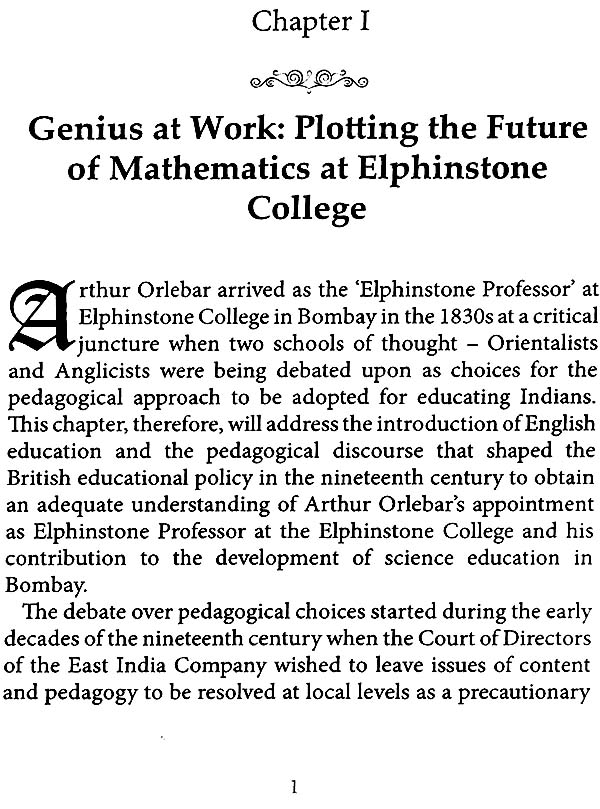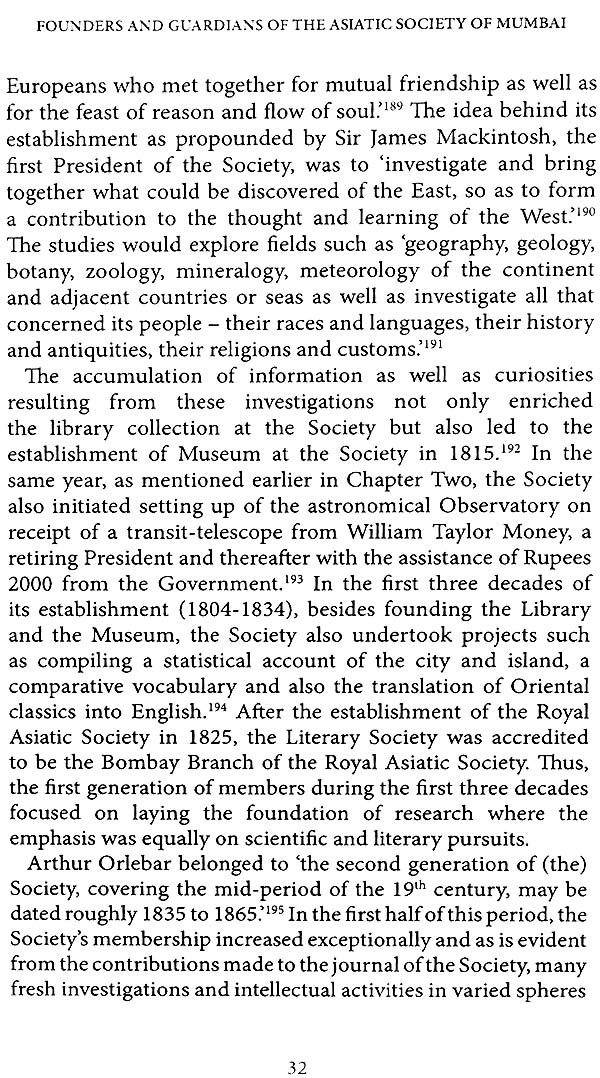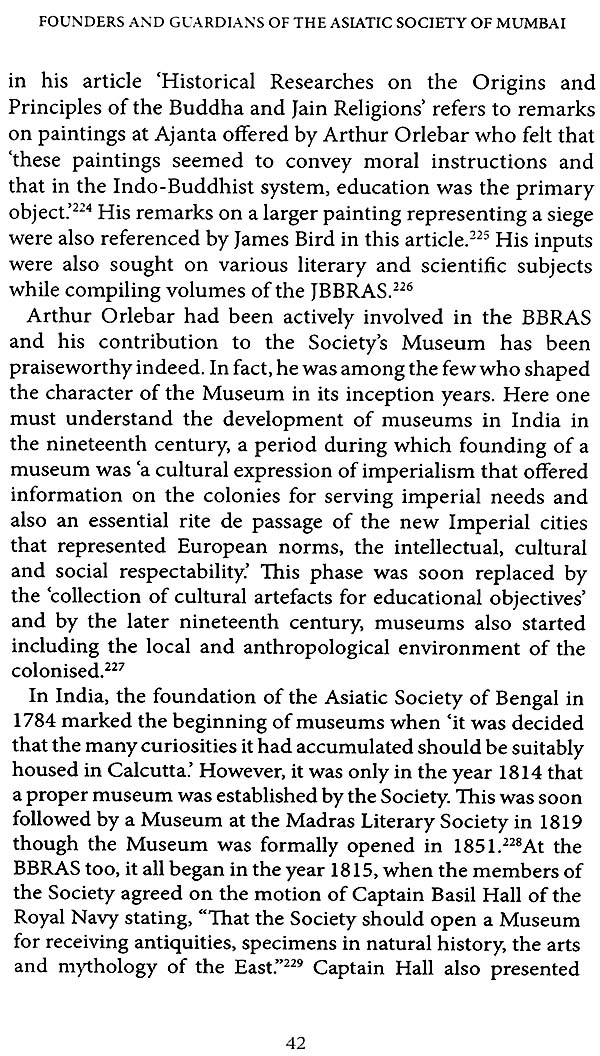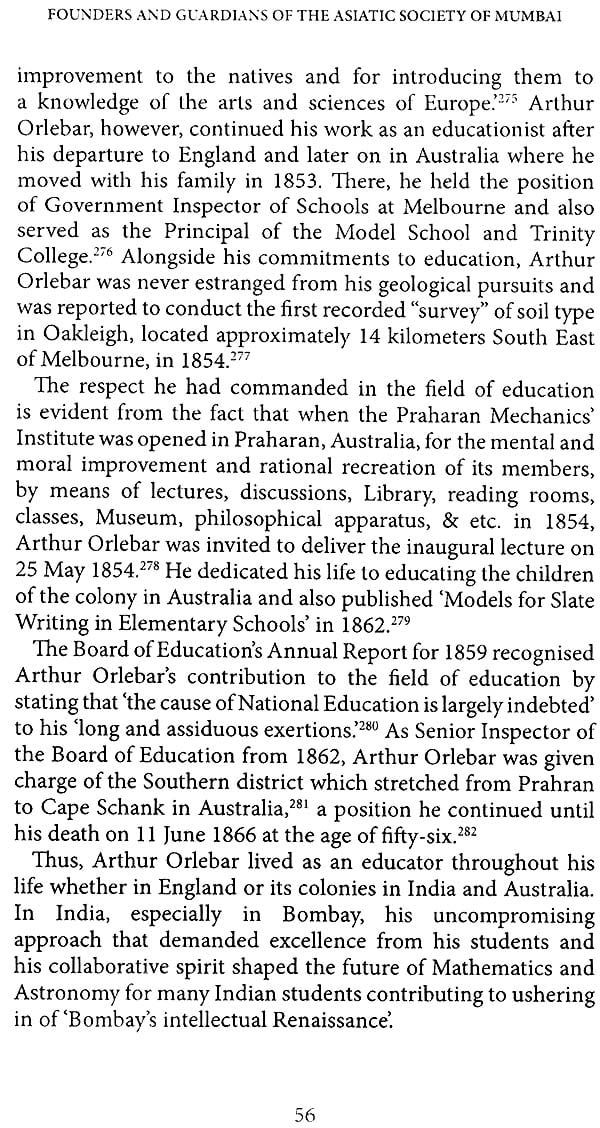
Arthur Bedford Orlebar (Founders and Guardians of The Asiatic Society of Mumbai)
Book Specification
| Item Code: | NAP579 |
| Author: | Vrunda Pathare |
| Publisher: | Indus Source Books |
| Language: | English |
| Edition: | 2018 |
| ISBN: | 9789385509360 |
| Pages: | 104 |
| Cover: | Paperback |
| Other Details | 8.5 inch X 5.5 inch |
| Weight | 160 gm |
Book Description
Professor Arthur Bedford Orlebar (1810-1866) arrived in Bombay (now Mumbai) in 1835 as the Elphinstone Professor and was also given charge of the Colaba Observatory. Born on 11 June 1810 in the county of Bedford in England, Orlebar graduated from Lincoln College, Oxford in 1833. With a degree in Mathematics, Arthur Orlebar applied for the Elphinstone Professorship in India announced by the Bombay Native Education Society in honour of departing Governor Mountstuart Elphinstone (1779-1859). He also served as a Government Inspector of Schools at Bombay from 1842. As a superintendent of the Observatory at Colaba, he contributed immensely to initial development of the Observatory in the 1840s. Alongside educational responsibilities and astronomical engagements, Orlebar soon got involved with activities of the Bombay Branch of Royal Asiatic Society (BBRAS) and Bombay Geographical Society. He dedicated himself to enriching the Museum collection at BBRAS and also devoted considerable time to classification work and recording antiquities at the Museum. Not only did he contribute scholarly articles to the journals of BBRAS but he was also instrumental in having the first two quarterly journals of the Society published. In 1847, while his course book on Mathematics was in progress, he had to take the difficult decision of leaving India since Bombay was not conducive to his health. He continued his work as an educationist after his departure to England and later in Australia where he moved with his family in 1853. He was the Government Inspector of Schools at Melbourne, Australia, a position he continued until his death on 11 June 1866 at the age of fifty-six.
During his decade long stint in Bombay, Arthur Orlebar donned many a hat as an educationist, mathematician, meteorologist, geologist and museum curator and played a crucial role in bringing about 'Bombay's intellectual renaissance.'
Vrunda Pathare is the Chief Archivist at Godrej Archives — a Business Archives of the Godrej Group (India). She is currently a Secretary of the Section of Business Archives (SBA) of the International Council of Archives (ICA) and also of the Oral History Association of India (OHAI). She has presented papers on aspects of archiving and business archives, at both national and international conferences.
Vrunda Pathare is the Chief Archivist at Godrej Archives - a Business Archives of the Godrej Group (India). She is currently a Secretary of the Section of Business Archives (SBA) of the International Council of Archives (ICA) and also of the Oral History Association of India (OHAI). She serves as a member of the Steering Committee for the Dr. Avabai Wadia and Dr. Bomanji Khurshedji Wadia Archives for Women and also as a Member of the Indian Institute of Management Ahmedabad (IIMA) Archive Committee. She is also a member of the Board of Studies of Ramnarain Ruia College and Jai Hind College (Mumbai). In the past, she had served as a member on the Advisory Board of Rajbhavan Archives of the Government of Maharashtra (India).
Vrunda has been trained in Records Management from National Archives of India and holds a postgraduate degree in History from University of Mumbai. She started her career as a Research Assistant to Sadashiv Gorakshkar (Former Director, CSMVS, Mumbai; Past President, Commonwealth Association of Museums) on the following projects:
1. `Rajbhavans in Maharashtra' - A book on the Comprehensive History of Rajbhavans in Maharashtra published in the year 2002 and
2. ONGC (Oil and Natural Gas Corporation Ltd.) Museum Project.
Later, she worked as an Assistant Archivist at TIFR Archives, Mumbai and was responsible for the collection, arrangement and dissemination of archival resources reflecting the scientific legacy of TIFR.
She has presented papers on aspects of archiving and business archives, at both national as well as international conferences.
During his tenure of six years as President of the Asiatic Society, Dr. Aroon Tikekar took several initiatives with a view to resuscitating the culture of research and scholarly studies focused on Mumbai, Maharashtra and western India. The project for bringing out monographs of about 100 pages on the Founders and Guardians of the Asiatic Society occupied a pivotal place in his vision. He was a scholar who was deeply interested in 19th century India. It was his firm conviction that the Asiatic Society had contributed substantially to 'intellectualising Mumbai' under the leadership and inspiration of a group of scholars who could be truly called the Founders and Guardians of the Society. He had a grand plan for publishing monographs on 26 such outstanding personalities. He encouraged research scholars associated with the Society to undertake the writing of these monographs and guided them about resource materials, particularly materials that were available in the Library of the Asiatic Society itself. He had explained that "during two centuries and more of its fruitful existence, its members have made pioneering and lasting contributions to many fields of higher enquiry, philosophical as well as empirical. Much of this contribution has been recognised and lauded by the world of scholarship in India and outside. However, there were some scholars associated with the Society whose significant contribution to various fields such as iconography, numismatics, epigraphy, geology, geography, folklore and allied subjects has remained unknown or underestimated. The yields of their intellectual labour deserve to be brought to light."
The project envisaging publication of at least 25 such monographs became a part of the Society's 'Five Year Plan: Though the initial schedule of publication could not be maintained, 15 monographs have been brought out so far as listed below:
1. Edward Moor by Dr. Mridula Ramanna
2. John Faithfull Fleet by Dr. Leela B. Jois and Dr. Purnima Srikrishna
3. Sir George Birdwood by Dr. Vijaya Gupchup
4. Alexander Kinloch Forbes by Mr. Deepak Mehta
5. The Jervis Brothers — George Risto Jervis & Thomas Best Jervis by Prof. J. V. Naik & Dr. Prabha Ravi Shankar
6. Sir James Mackintosh (1765-1832) - Founder of the Literary Society of Bombay (1804) by Ms. Mrinal Kulkarni
7. William Erskine (1773-1852) - Secretary of Bombay Literary Society by Dr. Usha Thakkar
8. Rev. P. Anderson (1816-1857) - author of The English in Western India by Dr. Louiza Rodrigues
9. W.E. Frere (1811-1880) - President of both the Bombay Branch of the Royal Asiatic Society (BBRAS) as well as the Bombay Geographical Society by Dr. Usha R. Vijailakshmi
10. Dr. George Buehler (1837-1898) - Philologist & Epigraphist by Ms. Vaishali Karmarkar
11. Dr. George Buist (1805-1860) by Dr. Aroon Tikekar
12. William Henry Sykes (1790-1872) by Dr. Sonali Pednekar
13. Peter Peterson (1847-1899) by Dr. Namrata Ganneri
14. John Briggs ((1785-1875) by Dr. Prabha Ravi Shankar
15. Henry John Carter (1813-1895) by Dr. Ravinder Kaur Cheema
The implementation of the plan received a sudden setback when Dr. Aroon Tikekar passed away on 19 January 2016.
This was a cruel blow to the members of the Society and to the large circle of his friends and admirers. It was clear that in the absence of Dr. Tikekar, the stewardship of the project would have to be entrusted to a group rather than an individual. Accordingly, the Society constituted a Committee with Dr. Usha Thakkar as the Chairperson and Dr. Mridula Ramana, Mr. Yogesh Kamdar and Prof. Mangala Sirdeshpande, as members. The Committee was to complete the unfinished task because that would be the best way of paying homage to the memory of Dr. Tikekar. The Committee has toiled to motivate scholars who were assigned the work of certain monographs. By maintaining constant follow-ups, the Committee has been successful in getting 8 monographs to the stage of publication. The Committee deserves gratitude for its endeavours and good wishes for its efforts to get more and more monographs completed so as to fulfil the vision of Dr. Tikekar.
At a monthly meeting of the Bombay Branch of the Royal Asiatic Society (BBRAS) held in the library room on 11 February 1847, a resolution was proposed by Rev. J Stevenson DD., the Vice President of the Society and seconded by Rev. G. Pigott to honour the services of Arthur Bedford Orlebar. It summed up the various responsibilities that the versatile Arthur Orlebar carried out in his decade-long stint at Bombay between 1835-1847. It was unanimously resolved: that in consideration of the many and deep obligations which this society is under to Prof. Orlebar, both for the assiduous labour and varied talents which he has devoted to the classification of the Museum, in all its branches, as well as for the zeal which he has invariably displayed in furthering its literary and scientific objects, this society do convey to Prof. Orlebar, through their Secretary, their sincere regret at the cause which has compelled him to finally leave India, with an expression of their high sense and appreciation of the extent and value of his former service as Secretary (already placed on record in the proceeding of the society) and since as conservator of the Museum."
Born on 11 June 1810 to Robert-Charles and Charlotte Orlebar of Husborne Crawley in the county of Bedford in England,' Orlebar completed his matriculation at St. John's College and was elected scholar at Lincoln College, Oxford' during 1830-1833 from where he graduated. With a degree in Mathematics, Orlebar applied for the Elphinstone Professorship in India announced by the Bombay Native Education Society in honour of departing Governor Mountstuart Elphinstone (1779-1859). Soon after his arrival in Bombay (now Mumbai) in 1835 as Elphinstone Professor, Arthur Orlebar got involved with the activities of BBRAS and the Bombay Geographical Society. On 22 February 1838, he got married at Colaba Church4 to his cousin Eliza-Hannah Orlebar (1820-1857), the youngest daughter and 8th child of Richard Orlebar, Esq. of Hinwick House, Bedfordshire and Maria Orlebar.'
Alongside his responsibilities as a Professor at Elphinstone College, Arthur Orlebar also served as a Government Inspector of Schools at Bombay from 1842. He was also in charge of the Colaba Observatory and at the same time, tirelessly extended himself to enriching the Museum collection at BBRAS, devoting considerable time to classification work and recording antiquities at the Museum. He not only contributed scholarly articles to the journals of BBRAS but was also instrumental in having the first two quarterly journals of the Society published.' From 1842 to 1844, Arthur Orlebar moved back to England due to ill-health and completed his Masters of Arts in 1842 while in England.' He returned in 1844 and resumed his responsibilities of as a Professor of Elphinstone College and as a superintendent of the Observatory. In 1847, while his course book on Mathematics was in progress, he had to take the difficult decision of leaving India since Bombay was not conducive to his health. He continued his work as an educationist after his departure to England. He taught Richard Orlebar (1833-1920), son of Richard-Longuet Orlebar (1806-1870), brother and the administrator of the personal estate of his wife — Eliza-Hannah Orlebar and another student Salusbury Payne at Oxford as a tutor in 1847. After his pupil, Richard Orlebar moved to Rugby in 1848, Arthur Orlebar moved with his family to Australia in 1853. There, he held the position of Government Inspector of Schools at Melbourne, Australia, a position he continued until his death on 11 June 1866 at the age of fifty-six.' He was buried at the cemetery at S. Hilda, near Melbourne, Australia.' If one looks at his career in Bombay, Arthur Orlebar seems to have donned many-a-hat - that of a mathematician, an educationist, a geologist, an astronomer and a museum curator - working towards the fulfilment of the Elphinstonian objective that seeks to offer 'intellectual and moral improvement to the natives and for introducing them to a knowledge of the arts and sciences of He belonged to, what J.V. Naik has described as, 'the seed period of Bombay's intellectual renaissance'" but was also undoubtedly a product of his era where 'knowledge' appeared to largely flow in a 'unidirectional way from Europe to the non-West:" It would be significant, therefore, to contextualise Arthur Orlebar's work within the framework of a much larger story that forms a part of the pedagogical discourse on diffusion of knowledge in the colonial period, the emergence of new systems of knowledge decoding the natural world of the colonised lands and institutionalisation of scientific knowledge that started in the early 19th century as a direct consequence of the hegemonic assertion of colonial power around the 18th century.
Backdrop History took a significant turn in the year 1813. The East India Company's monopoly for trade in India was abolished giving impetus to commercial activities in the island city of Bombay." Political events that followed stimulated further expansion of internal trade. 'Dethronement of the dynasty of the Peshwas in 1818 followed by the annexation of the Deccan, opened up the link between the port and the mainland encouraging free and uninterrupted trade:14 Mountstuart Elphinstone, who 'was at the helm of affairs of the Presidency, was very anxious to facilitate the intercourse of the inhabitants of the island with the Deccan and to develop its trade in that direction:I5 Writing about this period, Bishop Heber who was in Bombay in the middle of the year 1825 says Bombay is the port from whence almost all the trade of the west and north is shipped from China and England; there are several ships building in the slips, and the whole place has the appearance of being a flourishing commercial sea-plot.
Contents
| List of Abbreviations | viii | |
| Foreword | ix | |
| A Note from the General Editor | xii | |
| Acknowledgements | xv | |
| Introduction | xvii | |
| I | Genius at Work: Plotting the Future of Mathematics at Elphinstone College | 1 |
| II | Meteorological Musings:The Colaba Observatory | 17 |
| III | Asiatic Odyssey | 31 |
| IV | Epilogue | 53 |
| Appendix | 57 | |
| Notes | 59 | |
| Bibliography | 78 |
Sample Pages









